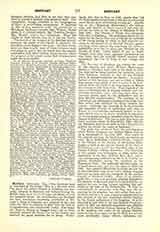

Breviary, ABERDEEN, the.—This breviary may be described as the Sarum Office in a Scottish form. The use of the ancient Church of Salisbury was generally adopted in Scotland and Ireland during the Middle Ages, both for the Liturgy (or Mass) and for the canonical hours. Its introduction into Scotland has been sometimes incorrectly attributed to Edward I, King of England, and assigned to the year 12921 but there is evidence to show that the date of its introduction was considerably earlier. For example, Herbert, Bishop of Glasgow from 1147 to 1164, certainly adopted the Sarum Use for his church, and received the papal sanction for so doing. Father Innes, who died in Paris in 1744, asserts that “all the Scots missals or breviaries I ever saw are secundum usum Sarum, local saints being written in”. According to the “Registrum Moraviense”, the bishop, dean, and chapter of Moray received and duly approved the Ordo of the Church of Salisbury in the year 1242. The Diocese of Moray was contiguous with that of Aberdeen. The preference shown by the Scots for the Sarum. Rite was evidently the outcome of the strong feeling, of which we find constant evidence in the history of the Scottish Church, against anything which seemed like admitting the claim to jurisdiction over her so often put forward by the Church of York. There might, it was no doubt, thought, have been some apparent justification for this claim, had the Scottish Church adopted and maintained the Use of York in her liturgy and office.
The Breviary of Aberdeen was mainly the work of the learned and pious William Elphinstone, Bishop of Aberdeen from 1483 to his death in 1514. Not only did he bring together the materials, but in some instances, notably in that of the Scottish saints, he himself composed the lessons. A peculiar feature of this breviary, and one in which it differs from nearly every other, is that in some of the festivals of saints the whole of the nine lessons at Matins are concerned with their lives. These legends of the saints of Scotland are of singular interest and considerable historical value, and they have been extensively drawn upon by the Bollandists and the later Scottish martyrologists. The accuracy of the quotations and references occurring in the book have been tested and admitted by many modern historians. Although the breviary is in its structure and essentials entirely in uniformity with that of Sarum, it is nevertheless exclusively proper to Scotland, and it was, as we know, intended to supersede all service-books issued in connection with the famous Church of Salisbury. This fact is quite clear from the royal mandate dated September 15, 1501, wherein the Aberdeen book is set forth as the “Breviary for general use within the realm of Scotland“.
The work was produced from the printing-press which Walter Chapman and Andrew Myllar had set up in Edinburgh, in the year 1507. Four copies of the original breviary (in black-letter) are known to exist; one in Edinburgh University library; a second in the Library of the Faculty of Advocates, Edinburgh; a third in the private library of the Earl of Strathmore; and a fourth (an imperfect copy) in the library of King’s College, Aberdeen. The reprinting of the volume was undertaken in 1854, under the supervision of the Rev. William Blew, M.A., and it was subsequently published by Mr. G. J. Toovey, for private circulation among the members of the Bannatyne Club. The originally printed copies are of small octavo size, and bear the dates of 1509 and 1510. As a printed Office-book its actual use was but of short duration, only about half a century elapsing between its issue and the overthrow of the ancient Church of Scotland (1560). There is no positive proof that it was ever generally adopted throughout the dioceses of Scotland; indeed the probabilities are against its ever having become anything like universal at the time of the Reformation. It must be remembered, in connection with this, that the injunction for its adoption was civil rather than ecclesiastical, and there is some reason to suppose that on this account it was not considered strictly binding by the church authorities of the kingdom. It is interesting to note that in the new Scottish Proprium, which in 1903 was formally sanctioned and adopted for use in the Scottish dioceses forming the Province of St. Andrews (the cultus of the ancient Scottish saints having been approved by the Holy See several years previously), many collects, antiphons, etc. are found which have been borrowed from the offices in the Aberdeen Breviary.
D. O. HUNTER-BLAIR.

